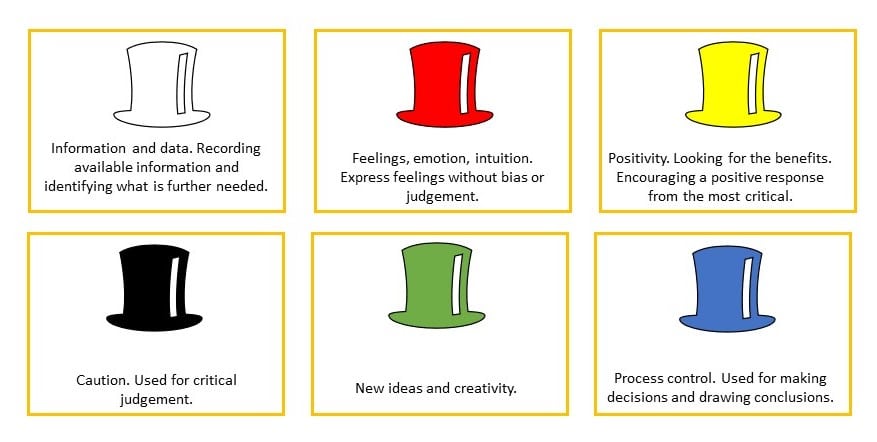Lockdown has caused a creativity crisis. People are finding it much harder to come up with new ideas, concepts and solutions. It is a well-documented issue with the Financial Times reporting that the creative spark has been hampered by remote working.*
So what can we do to keep the creative juices flowing when we work remotely? And how can we ensure that it is not just the loud people that get an opportunity to speak?
There are many creative thinking techniques and this series shares some of our favourites which work remarkably well in a remote environment. Next up – De Bono’s Hats.
De Bono’s Hats
Six Thinking Hats was written by Dr. Edward de Bono in 1985 and is a technique that enables a group to plan their thinking process and split thinking into six clear functions and roles. This way teams approach issues and ideas from a different angle.
De Bono identifies six distinct directions in which the brain can be challenged. In each of these directions the brain will identify certain aspects of issues being considered (e.g. gut instinct, pessimistic judgement and neutral facts.)
Each thinking role has a coloured thinking hat and by switching hats you can easily focus or redirect thoughts, the conversation, or the meeting. This gives structure to the thought process and enables all attendees to participate without the fear of being shot down or criticised.

The set up
In a Teams or Zoom environment this is easily achieved as you can get people to wear the different coloured hats. These don’t have to be actual hats – these can be t-shirts, items of clothing, coloured props, or a Teams background in the right shade. We particularly like the coloured props – you can go as creative as you want – to determine which ‘hat’ you are wearing!
Sequencing
When it comes to running a meeting you will need to establish the purpose and then work out the best sequence of hats. A few examples of sequence are listed in the table below
| ACTIVITY | HAT SEQUENCE |
| Initial Ideas | Blue, White, Green, Blue |
| Choosing between alternatives | Blue, White, (Green), Yellow, Black, Red, Blue |
| Identifying Solutions | Blue, White, Black, Green, Blue |
| Quick Feedback | Blue, Black, Green, Blue |
| Strategic Planning | Blue, Yellow, Black, White, Blue, Green, Blue |
| Process Improvement | Blue, White, White (Other People’s Views), Yellow, Black, Green, Red, Blue |
| Solving Problems | Blue, White, Green, Red, Yellow, Black, Green, Blue |
| Performance Review | Blue, Red, White, Yellow, Black, Green, Blue |
Sequences usually begin and end with a blue hat; the participants agree together how they will think, they do the thinking, then they evaluate the outcomes of that thinking and what they should do next.
You can either assign hats to the individual participants, or as a team. With a large number of participants you can use the break out rooms so smaller groups can work together with the same hats on. A good way of keeping the pace online is to assign each hat/colour for up to 5 minutes at a time and work through the sequence.
De Bono’s 6 hats is a great technique to approach creative thinking and will make sure everyone gets airtime and an opportunity to share their ideas.
Key outcomes
- Generate more and better ideas
- Quicker and more productive meetings
- Embrace collaboration and reduce conflict
- Spot opportunities where others see problems
- Think clearly and objectively
- View problems from new and unusual angles
- Achieve significant and meaningful results in a less time
If you need any help running workshops or need a critical friend to help get the creative thinking restarted, contact EstherM@NineFeetTall.com
*https://www.ft.com/content/27364b27-6c0c-4dec-b109-17c054b49465



